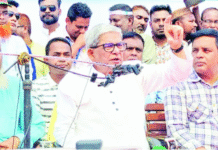
Rohingya refugees who fled from Myanmar make their way after crossing the border in Palang Khali, near Cox’s Bazar on Monday. —Reuters photo
The influx of Rohingyas into Bangladesh to flee violence in Myanmar beginning from August 25 surged further on Monday while 11 more bodies of the fleeing ethnic minority people drowned in the River Naf were recovered.
About 25,000 Rohingyas, mostly from Buthidaung, deep into the Rakhine state of Myanmar, fled to Bangladesh through land borders at Palangkhali of Ukhia and sea border at Shah Pari Dwip of Teknaf in Cox’s Bazar.
The new arrivals said that thousands more Rohingays were still waiting in forests and on hill slopes and at border in Myanmar side to contact fellows already entered Bangladesh.
They said that they left their country as violence continued and they were almost starving back in their homeland.
They, however, added that they had to dodge barriers of Myanmar authorities and local Buddhists while fleeing to Bangladesh.
Local people said that Rohingya exodus slowed down after mid September but slightly swelled in the first week of October against slowed down in October 10-15.
The influx surged again with about 25,000 Rohingyas entering the country on Monday.
About 20,000 Rohingyas arrived in Bangladesh through different border points at Palangkhali, said Border Guard Bangladesh 34 battalion second-in-command Major Iqbal Ahmed.
‘We have kept them near the border and are waiting for decision from high ups about taking them to the new camps,’ he said.
Taknaf upazila nirbahi officer Zahid Hossain Siddique said that at least 2,000 Rohingyas got them registered at different points at Shah Pari Dwip on Moday.
Many Rohngyas from Buthidaung continued taking dangerous sea route to flee to Bangladesh risking life. Rohingyas said that several thousand of Buthidaung resident are waiting at Godam Para of Maungdaw, opposite of Shah Parir Dwip to enter Bangladesh.
At least 11 people drowned and over 30 remained missing after a boat sailing from Godam Para with fleeing Rohingyas capsized in the River Naf early Monday.
‘The boat was carrying about 65 people when it sank on the estuary of the river at Pashchimpara point at about 4:00am,’ said Bangladesh Coast Guard in Shah Pari Dwip station commander Lieutenant Commander Imam Hossain Sajal.
Bodies of eleven –– five children and six women –– were found at different points of the Naf, and 21 people survived, Imam added.
He said that the small wooden mechanized fishing boat sank as it was overloaded and Coast Guard members rescued all of the survivors and bodies.
The incident took to 178 the number of fleeing Rohingyas, mostly women and children, drowned in the bay and the River Naf since August 25.
According to UN estimation on Sunday, 5,37,000 Rohingyas entered Bangladesh in the past 50 days in the new influx what the United Nations called the world’s fastest-developing refugee emergency.
Officials estimated that the new influx already took to 9.55 lakh the number of Myanmar nationals living in Bangladesh, entering the country at times since 1978.
Rohingyas fled violence and persecution in Rakhine in 1978, 1991-92 and October 2016 and almost all of them took shelter at Teknaf and Ukhia in Cox’s Bazar, which housed two registered and several unregistered Rohingya camps.
UN agencies and humanitarian groups working in Cox’s Bazar said that the concentration of Rohingyas in Cox’s Bazar was now amongst the densest in the world.
The new influx began after Myanmar security forces responded to Arakan Rohingya Salvation Army’s reported attacks on August 25 by launching violence what the United Nations denounced as ethnic cleansing.
Many Rohingyas took shelter at makeshift camps in reserved forests, felling trees and setting up shanties on hill slopes while some of them took shelter at overcrowded registered and unregistered camps.
Rohingya new arrivals entering through Palangkhali alleged that Myanmar security forces and Buddhist mobs continued to terrorise them into leaving the country. They said that Buddhists were looting frequently, taking away their food grains to force them to leave the country.
They also said that they were leaving their homeland due to hunger as they were not allowed to go to markets in their locality or some of them were closed and aid deliveries were restricted.
Hasina Bagum, 20, who came with five-member family, said that they had to leave in forests as they were not allowed to stay at house. ‘We left Buthidaung as we were not allowed to go to market to buy food,’ she said, adding that she heard that many markets were still closed.
‘I cannot control my tear seeing my children starving,’ said Hasina, who crossed hill and forest walking for eight days to reach Bangladesh to save life.
Selim Ullah, 30, who came with four-member family, said that they tried to live at their village but in was impossible as Mynamar military and Buddhists were terrorising them to flee.
Both of them alleged that they faced obstacles from security forces and Buddhists when they were fleeing to Bangladesh.
‘They allured us saying that reliefs would be distributed,’ said Selim, who entered Bangladesh walking for 10 days.
The new arrivals said that about 30,000 compatriots were waiting at different points for entering Bangladesh.
The influx already overcrowded the existing permanent and makeshift health facilities in Cox’s Bazar and the scattered, unhygienic, crowded living conditions of half-starved and tired Rohingyas continued posing threat to public health.
To cope with the situation, a 60-bed field hospital, run by the Norwegian and Finnish Red Cross, was opened on Monday to provide vital healthcare to thousands of people from Myanmar living in dire conditions in Cox’s Bazar, International Federation of Red Cross and Red Crescent said in a statement.
The hospital has three wards, an operation theatre, delivery suite with maternity ward, psychosocial support, an outpatient department and an isolation unit.
‘Families have spent weeks in appalling conditions since fleeing Rakhine,’ said the chief medical officer at the hospital Pentti Haatanen of Finnish Red Cross.
‘There is also a very real risk of a waterborne disease outbreak, like cholera. The hospital’s isolation unit will help us deal with this if the worst happens,’ Pentti Haatanen added.
Malaysian deputy prime minister Ahmad Zahid Hamidi and International Organisation for Migration director general William Lacy Swing, visited different Rohingya camps in Cox’s Bazar to observe the current humanitarian crisis on Monday.
Source: New Age









